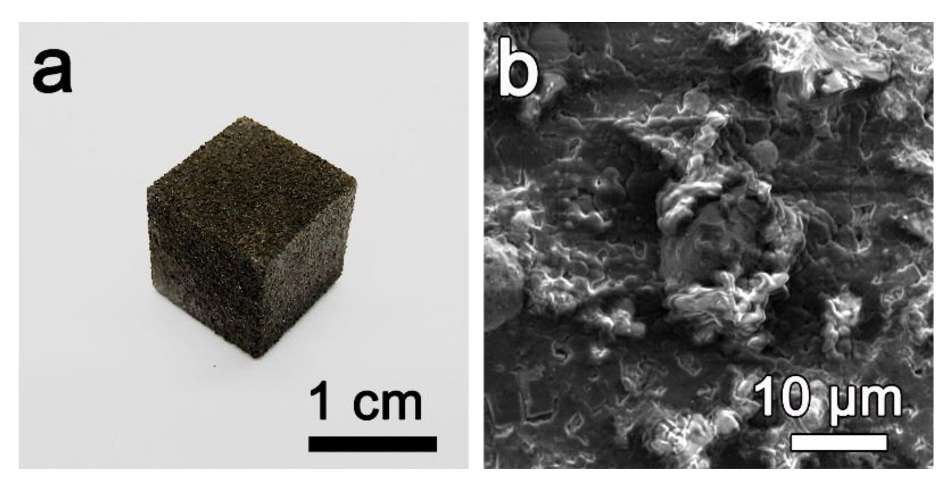Jun 22 2017
Centimeter-sized objects made of atomically thin graphene have been developed by Nanotechnologists from Rice University and Tianjin University, China. They achieved this by using 3D laser printing technique.
 Laser sintering was used to 3-D print objects made of graphene foam, a 3-D version of atomically thin graphene. At left is a photo of a fingertip-sized cube of graphene foam; at right is a close-up of the material as seen with a scanning electron microscope. CREDIT: Tour Group/Rice University.
Laser sintering was used to 3-D print objects made of graphene foam, a 3-D version of atomically thin graphene. At left is a photo of a fingertip-sized cube of graphene foam; at right is a close-up of the material as seen with a scanning electron microscope. CREDIT: Tour Group/Rice University.
The research could yield industrially useful amounts of atomically thin graphene. The outcomes of the study have been reported in a paper published online in the American Chemical Society journal ACS Nano.
This study is a first of its kind. We have shown how to make 3-D graphene foams from non-graphene starting materials, and the method lends itself to being scaled to graphene foams for additive manufacturing applications with pore-size control.
James Tour, Rice Chemist and Co-Corresponding Author
A widely researched nanomaterial of the decade, graphene is a two-dimensional sheet formed of pure carbon and is highly conductive as well as ultrastrong. Researchers hope to use graphene for nanoelectronics, aircraft de-icers, batteries, bone implants, and so on. However, much of the industrial usage mandates bulk amounts of graphene in a three-dimensional form. Hence Researchers have strived hard to discover simple techniques for synthesizing bulk 3D graphene.
In late 2016, for instance, Researchers in Tour’s lab started using lasers, nickel and powdered sugar to produce 3D graphene foam. In early 2016, they demonstrated that the foam could be reinforced with carbon nanotubes, producing a material called as “rebar graphene,” which had the ability to retain its shape even when it supported a weight 3000 times that of its own. However, it was not easy to synthesize rebar graphene as it required a 1000 °C chemical vapor deposition (CVD) process, use of a pre-fabricated 3D mold, and close to three hours of heating and cooling.
In a more recent research, Researchers from Tour’s lab as well as the labs of Jun Luo and Tianjin’s Naiqin Zhao of Rice University used a common 3D printing technology to synthesize fingertip-size blocks of graphene foam. The process, which is carried out at room temperature, does not require the use of molds and the starting materials are powdered sugar and nickel powder.
This simple and efficient method does away with the need for both cold-press molds and high-temperature CVD treatment. We should also be able to use this process to produce specific types of graphene foam like 3-D printed rebar graphene as well as both nitrogen- and sulfur-doped graphene foam by changing the precursor powders.
Junwei Sha, Co-lead Author of the study and a former student in Tour’s lab
The working of 3D laser printers is different from that of the well-known extrusion-based 3D printers, in which objects are synthesized by squeezing melted plastic through a needle while tracing out two-dimensional patterns. In the process of 3D laser sintering, a laser is directed toward a flat bed of powder. The laser sinters or melts the powder into a solid form wherever it contacts the powder. The laser is rastered (i.e. moved back and forth) line by line to develop a single two-dimensional slice of a huge object. Subsequently, a new powder layer is deposited on top of that layer, and the procedure is repeated to develop three-dimensional objects from consecutive two-dimensional layers.
The innovative Rice process involved using a commercially accessible CO2 laser. When light from the laser was directed onto the nickel and sugar powder, the sugar got melted and the nickel served as a catalyst. Graphene is formed when the mixture is cooled once the laser moves on to melt sugar in another spot. Sha and his team members performed an exhaustive research to obtain the ideal amount of laser power and time needed to increase graphene production.
The graphene foam created by this process is a low-density, 3D form of graphene with large pores that account for more than 99 percent of its volume.
“The 3-D graphene foams prepared by our method show promise for applications that require rapid prototyping and manufacturing of 3-D carbon materials, including energy storage, damping and sound absorption,
Yilun Li, Co-lead Author and Graduate Student, Rice University
Tour is a Professor of Computer Science and of Materials Science and Nanoengineering at Rice University and the T.T. and W.F. Chao Chair in Chemistry.
Rodrigo Villegas Salvatierra, Tuo Wang, Pei Dong, Yongsung Ji, Seoung-Ki Lee, Chenhao Zhang, Jibo Zhang, and Pulickel Ajayan, all belonging to Rice University, and Robert Smith of Qualified Rapid Products in West Jordan, Utah, are the additional Co-Authors of the study.
The Air Force Office of Scientific Research and its Multidisciplinary University Research Initiative, the China Scholarship Council, the State Key Program of National Natural Science of China, the National Natural Science Foundation of China, and the Special Foundation for Science and Technology Major Program of Tianjin and Universal Laser Systems supported the study.